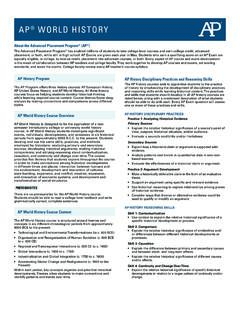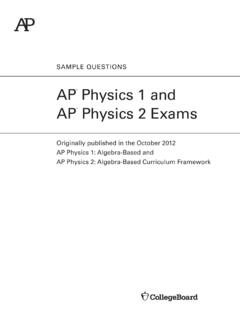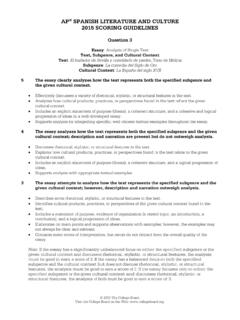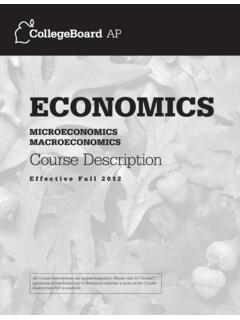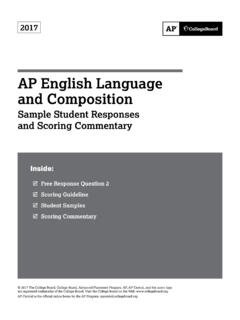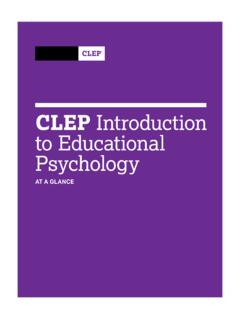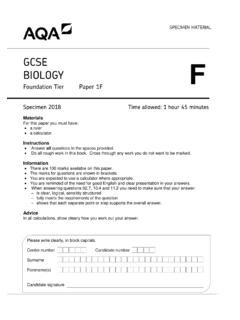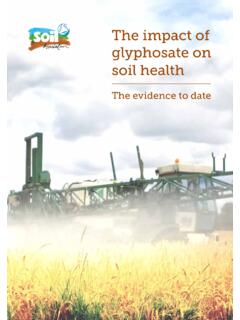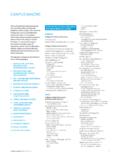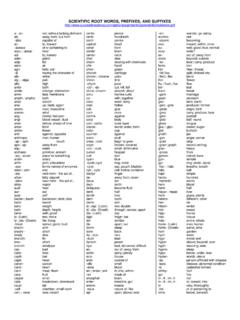Transcription of AP Biology 2017 Free-Response Questions - College Board
1 2017. AP Biology Free-Response Questions 2017 The College Board . College Board , Advanced Placement Program, AP, AP Central, and the acorn logo are registered trademarks of the College Board . Visit the College Board on the Web: AP Central is the official online home for the AP Program: 2017 AP Biology Free-Response Questions . Biology . Section II. 8 Questions Total Time 90 minutes Reading Period 10 minutes Writing Period 80 minutes Directions: Questions 1 and 2 are long Free-Response Questions that require about 22 minutes each to answer and are worth 10 points each. Questions 3 8 are short Free-Response Questions that require about 6 minutes each to answer. Questions 3 5 are worth 4 points each and Questions 6 8 are worth 3 points each. Read each question carefully and completely. You are advised to spend the 10-minute reading period planning your answers. You may begin writing your responses before the reading period is over. Write your response in the space provided for each question.
2 Only material written in the space provided will be scored. Answers must be written out in paragraph form. Outlines, bulleted lists, or diagrams alone are not acceptable. TABLE 1. EFFECT OF mM CAFFEINE ON MEMORY IN BEES. Memory Treatment (average probability of revisiting a nectar source 2SE X ). 10 Minutes 24 Hours Control Caffeine 1. In flowering plants, pollination is a process that leads to the fertilization of an egg and the production of seeds. Some flowers attract pollinators, such as bees, using visual and chemical cues. When a bee visits a flower, in addition to transferring pollen, the bee can take nectar from the flower and use it to make honey for the colony. Nectar contains sugar, but certain plants also produce caffeine in the nectar. Caffeine is a bitter-tasting compound that can be toxic to insects at high concentrations. To investigate the role of caffeine in nectar, a group of researchers studied the effect of mM caffeine on bee behavior.
3 The results of an experiment to test the effect of caffeine on bees' memory of a nectar source are shown in Table 1. 2017 The College Board . Visit the College Board on the Web: GO ON TO THE NEXT PAGE. -2- 2017 AP Biology Free-Response Questions . (a) On the axes provided, construct an appropriately labeled graph to illustrate the effect of caffeine on the probability of bees revisiting a nectar source (memory). (b) Based on the results, describe the effect of caffeine on each of the following: Short-term (10 minute) memory of a nectar source Long-term (24 hour) memory of a nectar source (c) Design an experiment using artificial flowers to investigate potential negative effects of increasing caffeine concentrations in nectar on the number of floral visits by bees. Identify the null hypothesis, an appropriate control treatment, and the predicted results that could be used to reject the null hypothesis. (d) Researchers found that nectar with caffeine tends to have a lower sugar content than nectar without caffeine.
4 Plants use less energy to produce the caffeine in nectar than they do to produce the sugar in nectar. Propose ONE benefit to plants that produce nectar with caffeine and a lower sugar content. Propose ONE cost to bees that visit the flowers of plants that produce nectar with caffeine and a lower sugar content. 2017 The College Board . Visit the College Board on the Web: GO ON TO THE NEXT PAGE. -3- 2017 AP Biology Free-Response Questions . Figure 1. The effect of karrikins (KAR) and trimethylbutenolides (TMB) on seed germination in Lactuca plants. Error bars represent 2 SE X . 2. Fires frequently occur in some ecosystems and can destroy all above-ground vegetation. Many species of plants in these ecosystems respond to compounds in smoke that regulate seed germination after a major fire. Karrikins (KAR) and trimethylbutenolides (TMB) are water-soluble compounds found in smoke that are deposited in the soil as a result of a fire. KAR and TMB bind to receptor proteins in a seed.
5 In a study on the effects of smoke on seeds, researchers recorded the timing and percent of seed germination in the presence of various combinations of KAR and TMB. The results are shown in Figure 1. In a second investigation into the effect of available water on seed germination after a fire, researchers treated seeds with KAR or TMB. The treated seeds were then divided into two treatment groups. One group received a water rinse and the other group received no water rinse. The seeds were then incubated along with a group of control seeds that were not treated. The results are shown in the table. EFFECT OF CHEMICAL TREATMENT AND WATER RINSE ON GERMINATION. Chemical Treatment Treatment Water Germination Result Group Rinse KAR TMB. 1 (control) Control result 2 + Different from control 3 + Different from control 4 (control) + Control result 5 + + Different from control 6 + + Same as control 2017 The College Board . Visit the College Board on the Web: GO ON TO THE NEXT PAGE.
6 -4- 2017 AP Biology Free-Response Questions . (a) The researchers made the following claims about the effect of KAR and the effect of TMB on seed germination relative to the control treatment. KAR alone affects the timing of seed germination. KAR alone affects the percentage of seeds that germinate. TMB alone affects the timing of seed germination. TMB alone affects the percentage of seeds that germinate. Provide support using data from Figure 1 for each of the researchers' claims. (b) Make a claim about the effect of rinsing on the binding of KAR to the receptor in the seed and about the effect of rinsing on the binding of TMB to the receptor in the seed. Identify the appropriate treatment groups and results from the table that, when compared with the controls, provide support for each claim. (c) There is intense competition by plants to successfully colonize areas that have been recently cleared by a fire. Describe ONE advantage of KAR regulation and ONE advantage of TMB regulation to plants that live in an ecosystem with regular fires.
7 2017 The College Board . Visit the College Board on the Web: GO ON TO THE NEXT PAGE. -5- 2017 AP Biology Free-Response Questions . 3. Gibberellin is the primary plant hormone that promotes stem elongation. GA 3-beta-hydroxylase (GA3H) is the enzyme that catalyzes the reaction that converts a precursor of gibberellin to the active form of gibberellin. A mutation in the GA3H gene results in a short plant phenotype. When a pure-breeding tall plant is crossed with a pure-breeding short plant, all offspring in the F1 generation are tall. When the F1 plants are crossed with each other, 75 percent of the plants in the F2 generation are tall and 25 percent of the plants are short. Figure 1. The universal genetic code (a) The wild-type allele encodes a GA3H enzyme with alanine (Ala), a nonpolar amino acid, at position 229. The mutant allele encodes a GA3H enzyme with threonine (Thr), a polar amino acid, at position 229. Describe the effect of the mutation on the enzyme and provide reasoning to support how this mutation results in a short plant phenotype in homozygous recessive plants.
8 (b) Using the codon chart provided, predict the change in the codon sequence that resulted in the substitution of alanine for threonine at amino acid position 229. (c) Describe how individuals with one (heterozygous) or two (homozygous) copies of the wild-type GA3H. allele can have the same phenotype. 2017 The College Board . Visit the College Board on the Web: GO ON TO THE NEXT PAGE. -6- 2017 AP Biology Free-Response Questions . DIETARY COMPOSITION OF ORGANISMS IN AN AQUATIC ECOSYSTEM. Food Source (% of diet). Organism Algae Stoneflies Midges Hellgrammites Caddisflies Algae Stoneflies 90 10. Midges 100. Hellgrammites 20 10 70. Caddisflies 70 30. 4. The table above shows how much each organism in an aquatic ecosystem relies on various food sources. The rows represent the organisms in the ecosystem, and the columns represent the food source. The percentages indicate the proportional dietary composition of each organism. High percentages indicate strong dependence of an organism on a food source.
9 (a) Based on the food sources indicated in the data table, construct a food web in the template below. Write the organism names on the appropriate lines AND draw the arrows necessary to indicate the energy flow between organisms in the ecosystem. (b) In an effort to control the number of midges, an area within the ecosystem was sprayed with the fungus Metarhizium anisopliae, which significantly decreased the midge population. Based on the data in the table, predict whether the spraying of the fungus will have the greatest short-term impact on the population of the stoneflies, the caddisflies, or the hellgrammites. Justify your prediction. 2017 The College Board . Visit the College Board on the Web: GO ON TO THE NEXT PAGE. -7- 2017 AP Biology Free-Response Questions . Figure 1. Characteristics of a pond community over time 5. Microcystis aeruginosis is a freshwater photosynthetic cyanobacterium. When temperatures increase and nutrients are readily available in its pond habitat, M.
10 Aeruginosis undergoes rapid cell division and forms an extremely large, visible mass of cells called an algal bloom. M. aeruginosis has a short life span and is decomposed by aerobic bacteria and fungi. Identify the metabolic pathway and the organism that is primarily responsible for the change in oxygen level in the pond between times I and II AND between times III and IV. 2017 The College Board . Visit the College Board on the Web: GO ON TO THE NEXT PAGE. -8- 2017 AP Biology Free-Response Questions . Figure 1. Comet assay to detect double-stranded breaks in DNA. 6. A comet assay is a technique used to determine the amount of double-strand breaks in DNA (DNA damage). in cells. The nucleus of an individual cell is placed on a microscope slide coated with an agarose gel. An electric current is applied to the gel that causes DNA to move (electrophoresis), and the DNA is stained with a fluorescent dye. When viewed using a microscope, undamaged DNA from the nucleus appears as a round shape (the head), and the fragments of damaged DNA extend out from the head (the tail).
